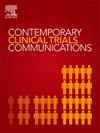An application of minimization for ensuring balanced study arms in a group-randomized COVID-19 educational intervention trial
IF 1.4
Q4 MEDICINE, RESEARCH & EXPERIMENTAL
引用次数: 0
Abstract
Background
Our institution carried out a multi-center, group-randomized controlled trial to evaluate the effectiveness of two community-based interventions on promoting the uptake of COVID-19 testing and vaccination in three regions with high levels of health disparities in Texas. We selected Census Block Groups (CBGs) with high disparity for randomization. In each study region, selected CBGs were randomized into two intervention groups and one control group. An important goal was to ensure balanced distributions of two continuous covariates, the disparity index and population size, across study arms. In this paper, we describe a novel minimization method used to ensure balanced study arms.
Methods
We employed a minimization method to balance distributions of disparity index and population size among the selected CBGs across three study groups. First, we used the means and standard deviations at the baseline to standardize covariates. Second, we used the maximum of pairwise Manhattan distances as the imbalance score. When randomizing a set of CBGs, we computed the imbalance scores for all possible assignments and used unequal allocation probabilities to implement randomization. We conducted a simulation study to evaluate the performance of the imbalance score.
Results
In both the simulation study and the actual randomization results of the trial, minimization yielded balanced groups on the marginal distributions of the disparity index and population size. In the trial, the study groups were highly homogenous regarding the joint distribution of disparity index and population size (p = 0.91).
Conclusion
The results indicate that the maximum of pairwise Manhattan distances is a practically useful imbalance score. Using this imbalance score, the minimization procedure satisfactorily balances the distribution of continuous covariates among three study groups.
求助全文
约1分钟内获得全文
求助全文
来源期刊

Contemporary Clinical Trials Communications
Pharmacology, Toxicology and Pharmaceutics-Pharmacology
CiteScore
2.70
自引率
6.70%
发文量
146
审稿时长
20 weeks
期刊介绍:
Contemporary Clinical Trials Communications is an international peer reviewed open access journal that publishes articles pertaining to all aspects of clinical trials, including, but not limited to, design, conduct, analysis, regulation and ethics. Manuscripts submitted should appeal to a readership drawn from a wide range of disciplines including medicine, life science, pharmaceutical science, biostatistics, epidemiology, computer science, management science, behavioral science, and bioethics. Contemporary Clinical Trials Communications is unique in that it is outside the confines of disease specifications, and it strives to increase the transparency of medical research and reduce publication bias by publishing scientifically valid original research findings irrespective of their perceived importance, significance or impact. Both randomized and non-randomized trials are within the scope of the Journal. Some common topics include trial design rationale and methods, operational methodologies and challenges, and positive and negative trial results. In addition to original research, the Journal also welcomes other types of communications including, but are not limited to, methodology reviews, perspectives and discussions. Through timely dissemination of advances in clinical trials, the goal of Contemporary Clinical Trials Communications is to serve as a platform to enhance the communication and collaboration within the global clinical trials community that ultimately advances this field of research for the benefit of patients.
 求助内容:
求助内容: 应助结果提醒方式:
应助结果提醒方式:


